MGT600: Critical Analysis of Organizational Change Management Report
VerifiedAdded on 2023/06/09
|10
|1830
|498
Report
AI Summary
This report analyzes a presentation on managing organizational change, focusing on the challenges and opportunities presented by globalization. It examines the importance of ethical behavior within organizations, particularly in the context of diverse values and technological advancements, and discusses the strategic planning needed to manage ethics. The report further explores systematic interventions, including the roles of employees, technology, and market dynamics, while considering consumer behavior and strategic marketing. The report emphasizes the need for leadership support, clear communication, and stakeholder involvement in successful change implementation. It also contrasts traditional and transformational leadership styles, highlighting the conscious change leader accountability model. The report critiques the presentation for its lack of theoretical depth and the omission of stakeholder diversity, while providing a framework for understanding the critical elements of effective organizational change management.
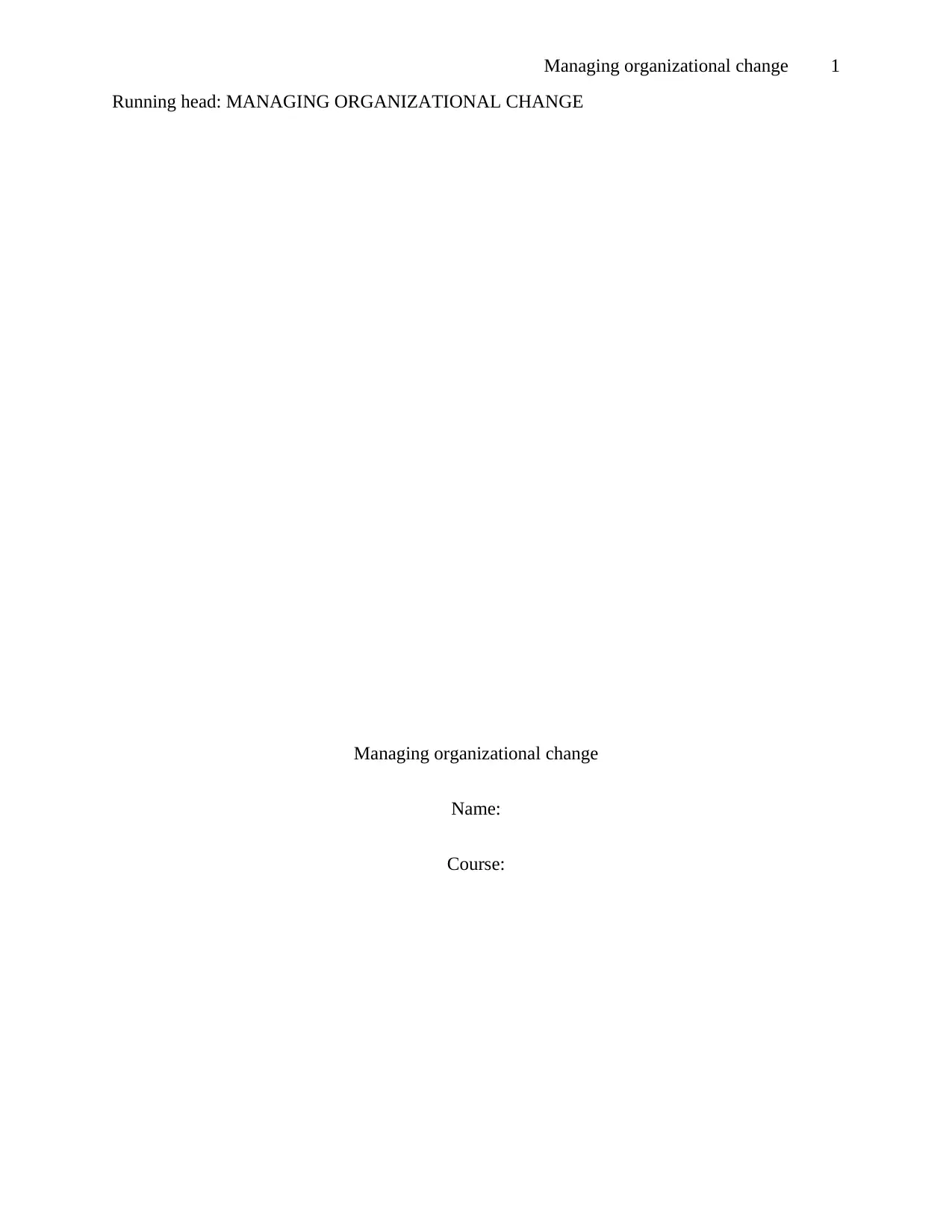
1Managing organizational change
Running head: MANAGING ORGANIZATIONAL CHANGE
Managing organizational change
Name:
Course:
Running head: MANAGING ORGANIZATIONAL CHANGE
Managing organizational change
Name:
Course:
Paraphrase This Document
Need a fresh take? Get an instant paraphrase of this document with our AI Paraphraser
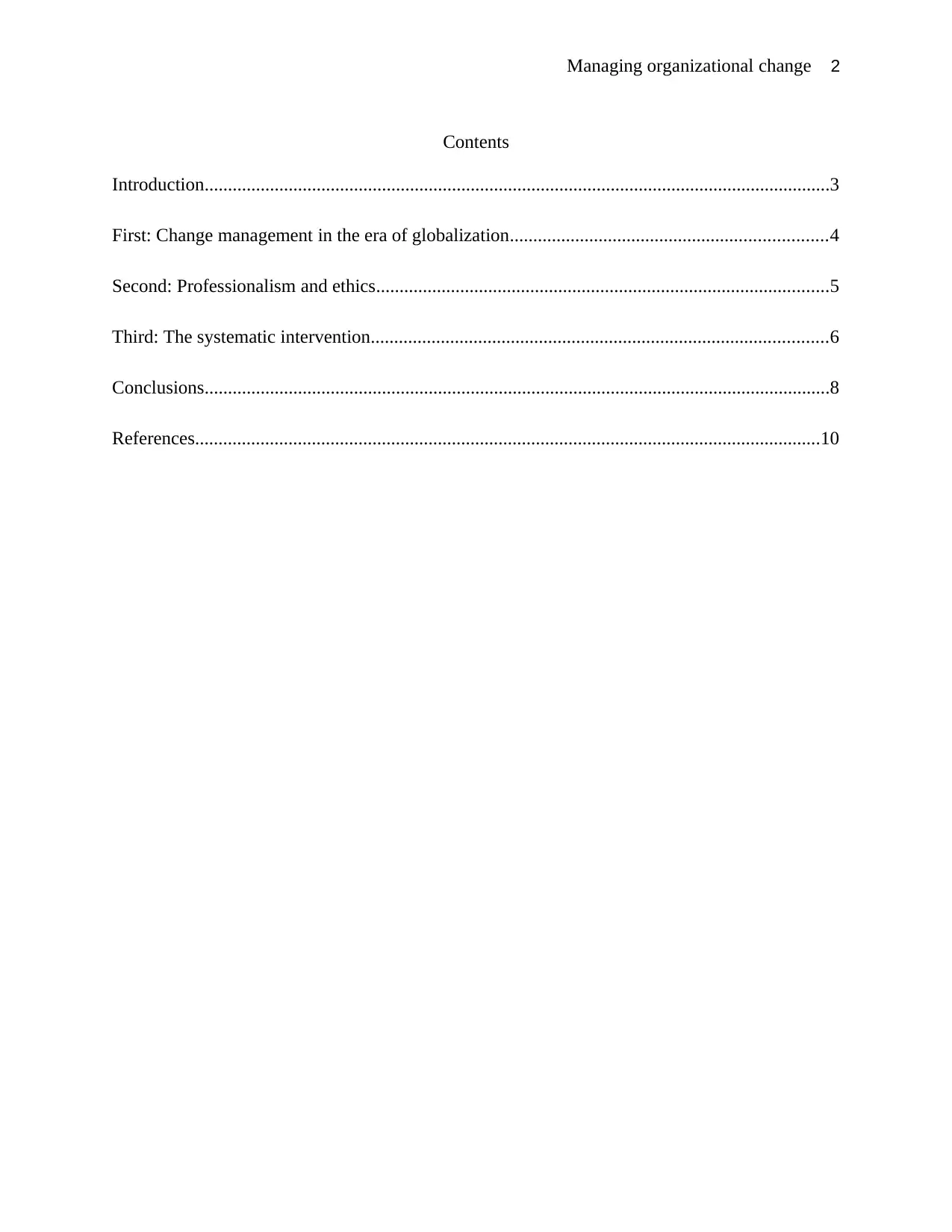
2Managing organizational change
Contents
Introduction......................................................................................................................................3
First: Change management in the era of globalization....................................................................4
Second: Professionalism and ethics.................................................................................................5
Third: The systematic intervention..................................................................................................6
Conclusions......................................................................................................................................8
References......................................................................................................................................10
Contents
Introduction......................................................................................................................................3
First: Change management in the era of globalization....................................................................4
Second: Professionalism and ethics.................................................................................................5
Third: The systematic intervention..................................................................................................6
Conclusions......................................................................................................................................8
References......................................................................................................................................10
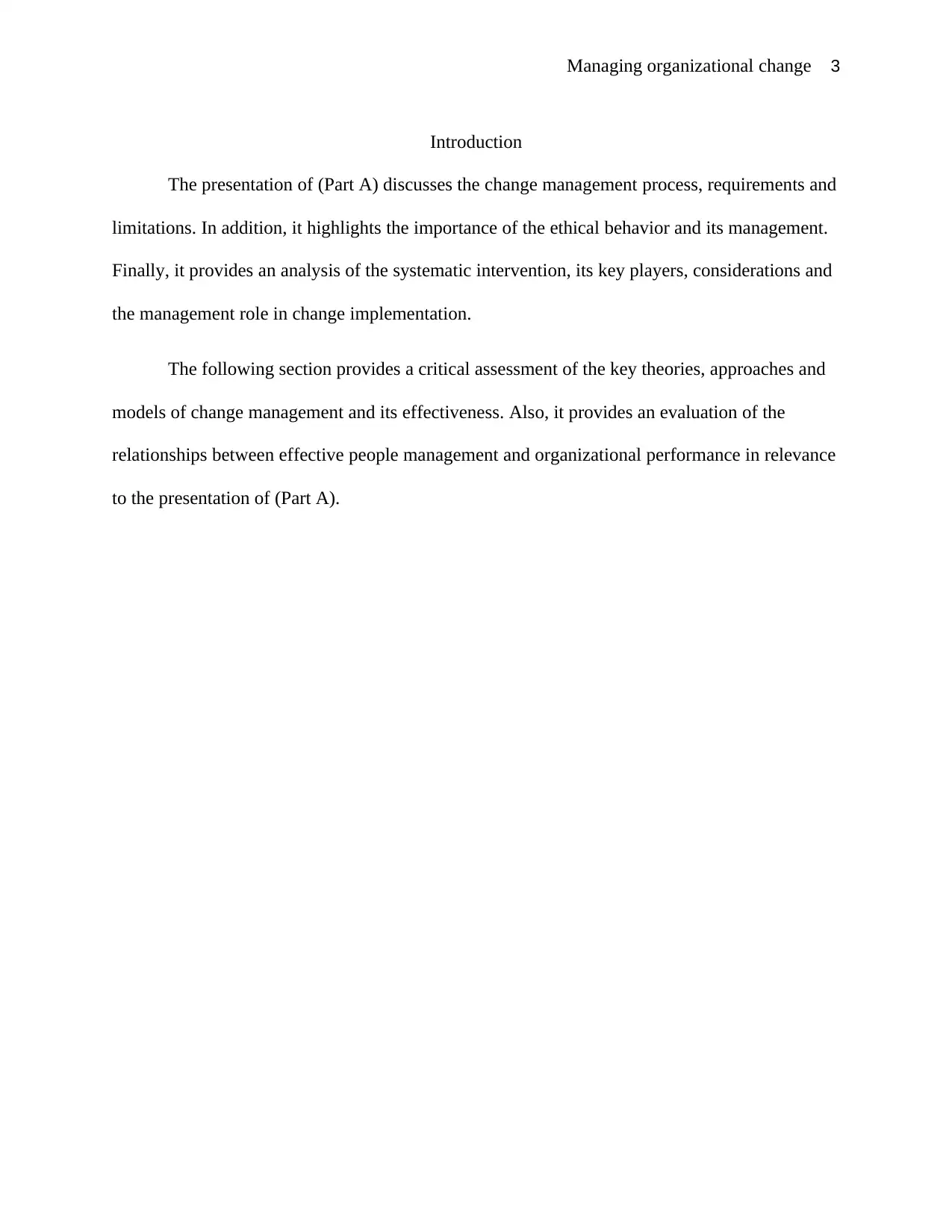
3Managing organizational change
Introduction
The presentation of (Part A) discusses the change management process, requirements and
limitations. In addition, it highlights the importance of the ethical behavior and its management.
Finally, it provides an analysis of the systematic intervention, its key players, considerations and
the management role in change implementation.
The following section provides a critical assessment of the key theories, approaches and
models of change management and its effectiveness. Also, it provides an evaluation of the
relationships between effective people management and organizational performance in relevance
to the presentation of (Part A).
Introduction
The presentation of (Part A) discusses the change management process, requirements and
limitations. In addition, it highlights the importance of the ethical behavior and its management.
Finally, it provides an analysis of the systematic intervention, its key players, considerations and
the management role in change implementation.
The following section provides a critical assessment of the key theories, approaches and
models of change management and its effectiveness. Also, it provides an evaluation of the
relationships between effective people management and organizational performance in relevance
to the presentation of (Part A).
⊘ This is a preview!⊘
Do you want full access?
Subscribe today to unlock all pages.

Trusted by 1+ million students worldwide
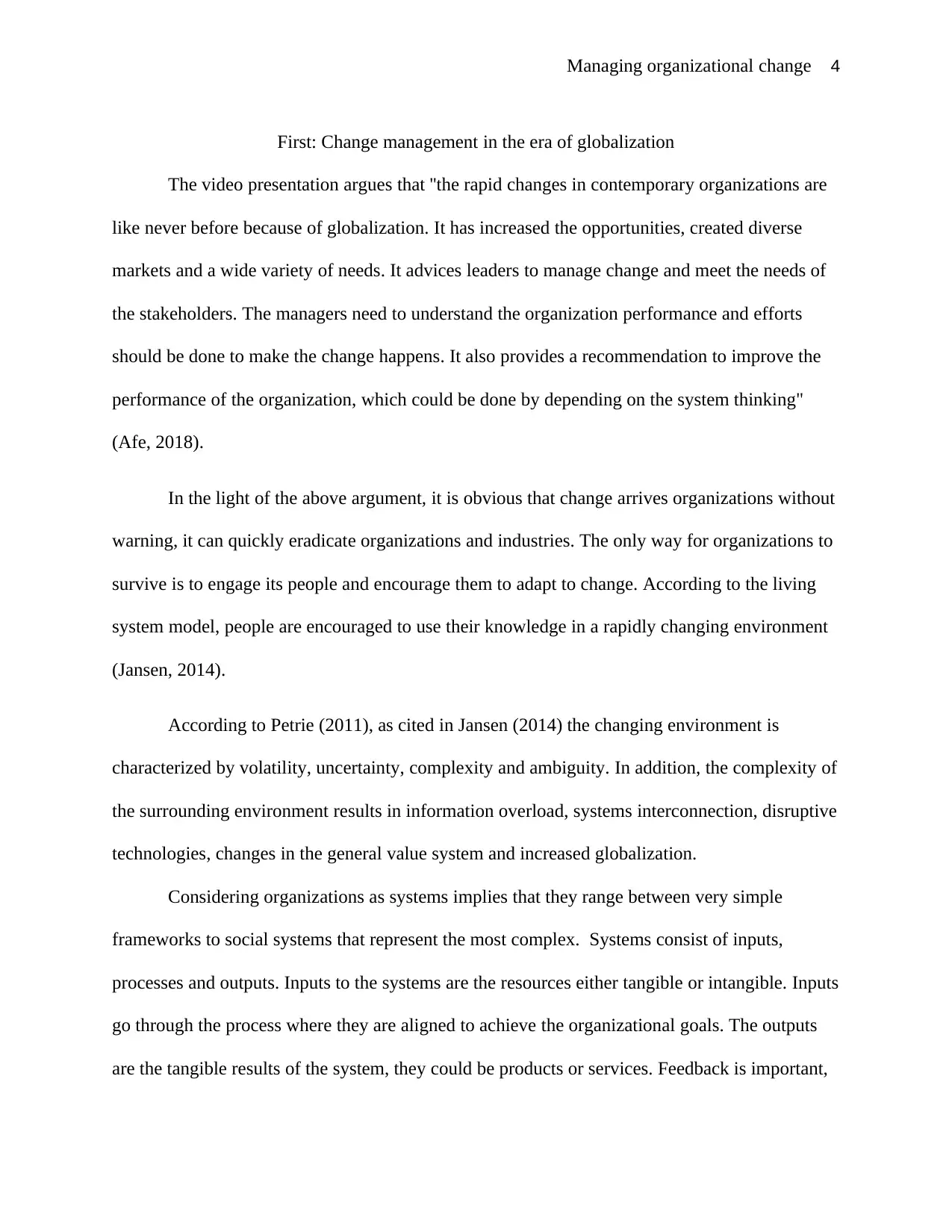
4Managing organizational change
First: Change management in the era of globalization
The video presentation argues that ''the rapid changes in contemporary organizations are
like never before because of globalization. It has increased the opportunities, created diverse
markets and a wide variety of needs. It advices leaders to manage change and meet the needs of
the stakeholders. The managers need to understand the organization performance and efforts
should be done to make the change happens. It also provides a recommendation to improve the
performance of the organization, which could be done by depending on the system thinking"
(Afe, 2018).
In the light of the above argument, it is obvious that change arrives organizations without
warning, it can quickly eradicate organizations and industries. The only way for organizations to
survive is to engage its people and encourage them to adapt to change. According to the living
system model, people are encouraged to use their knowledge in a rapidly changing environment
(Jansen, 2014).
According to Petrie (2011), as cited in Jansen (2014) the changing environment is
characterized by volatility, uncertainty, complexity and ambiguity. In addition, the complexity of
the surrounding environment results in information overload, systems interconnection, disruptive
technologies, changes in the general value system and increased globalization.
Considering organizations as systems implies that they range between very simple
frameworks to social systems that represent the most complex. Systems consist of inputs,
processes and outputs. Inputs to the systems are the resources either tangible or intangible. Inputs
go through the process where they are aligned to achieve the organizational goals. The outputs
are the tangible results of the system, they could be products or services. Feedback is important,
First: Change management in the era of globalization
The video presentation argues that ''the rapid changes in contemporary organizations are
like never before because of globalization. It has increased the opportunities, created diverse
markets and a wide variety of needs. It advices leaders to manage change and meet the needs of
the stakeholders. The managers need to understand the organization performance and efforts
should be done to make the change happens. It also provides a recommendation to improve the
performance of the organization, which could be done by depending on the system thinking"
(Afe, 2018).
In the light of the above argument, it is obvious that change arrives organizations without
warning, it can quickly eradicate organizations and industries. The only way for organizations to
survive is to engage its people and encourage them to adapt to change. According to the living
system model, people are encouraged to use their knowledge in a rapidly changing environment
(Jansen, 2014).
According to Petrie (2011), as cited in Jansen (2014) the changing environment is
characterized by volatility, uncertainty, complexity and ambiguity. In addition, the complexity of
the surrounding environment results in information overload, systems interconnection, disruptive
technologies, changes in the general value system and increased globalization.
Considering organizations as systems implies that they range between very simple
frameworks to social systems that represent the most complex. Systems consist of inputs,
processes and outputs. Inputs to the systems are the resources either tangible or intangible. Inputs
go through the process where they are aligned to achieve the organizational goals. The outputs
are the tangible results of the system, they could be products or services. Feedback is important,
Paraphrase This Document
Need a fresh take? Get an instant paraphrase of this document with our AI Paraphraser
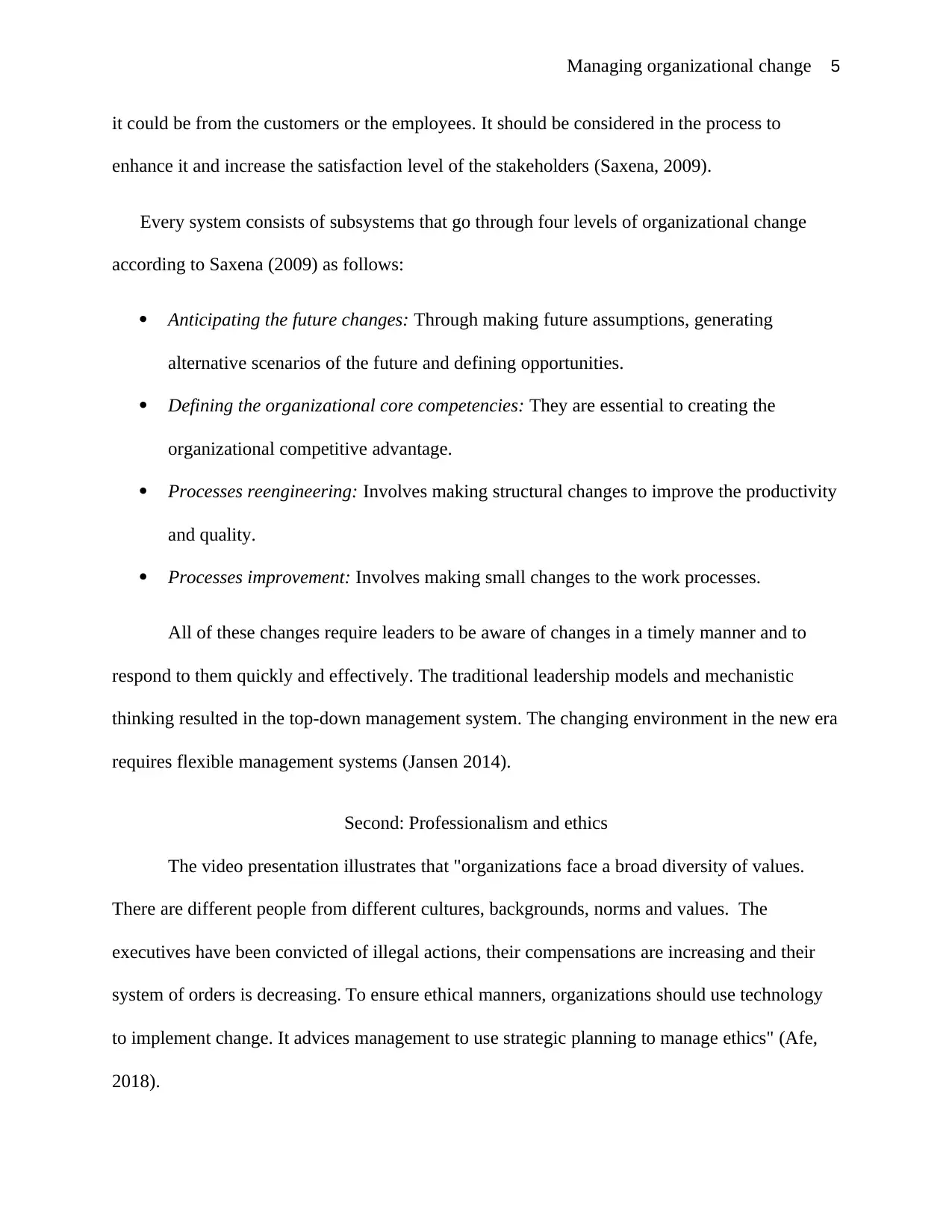
5Managing organizational change
it could be from the customers or the employees. It should be considered in the process to
enhance it and increase the satisfaction level of the stakeholders (Saxena, 2009).
Every system consists of subsystems that go through four levels of organizational change
according to Saxena (2009) as follows:
Anticipating the future changes: Through making future assumptions, generating
alternative scenarios of the future and defining opportunities.
Defining the organizational core competencies: They are essential to creating the
organizational competitive advantage.
Processes reengineering: Involves making structural changes to improve the productivity
and quality.
Processes improvement: Involves making small changes to the work processes.
All of these changes require leaders to be aware of changes in a timely manner and to
respond to them quickly and effectively. The traditional leadership models and mechanistic
thinking resulted in the top-down management system. The changing environment in the new era
requires flexible management systems (Jansen 2014).
Second: Professionalism and ethics
The video presentation illustrates that "organizations face a broad diversity of values.
There are different people from different cultures, backgrounds, norms and values. The
executives have been convicted of illegal actions, their compensations are increasing and their
system of orders is decreasing. To ensure ethical manners, organizations should use technology
to implement change. It advices management to use strategic planning to manage ethics" (Afe,
2018).
it could be from the customers or the employees. It should be considered in the process to
enhance it and increase the satisfaction level of the stakeholders (Saxena, 2009).
Every system consists of subsystems that go through four levels of organizational change
according to Saxena (2009) as follows:
Anticipating the future changes: Through making future assumptions, generating
alternative scenarios of the future and defining opportunities.
Defining the organizational core competencies: They are essential to creating the
organizational competitive advantage.
Processes reengineering: Involves making structural changes to improve the productivity
and quality.
Processes improvement: Involves making small changes to the work processes.
All of these changes require leaders to be aware of changes in a timely manner and to
respond to them quickly and effectively. The traditional leadership models and mechanistic
thinking resulted in the top-down management system. The changing environment in the new era
requires flexible management systems (Jansen 2014).
Second: Professionalism and ethics
The video presentation illustrates that "organizations face a broad diversity of values.
There are different people from different cultures, backgrounds, norms and values. The
executives have been convicted of illegal actions, their compensations are increasing and their
system of orders is decreasing. To ensure ethical manners, organizations should use technology
to implement change. It advices management to use strategic planning to manage ethics" (Afe,
2018).
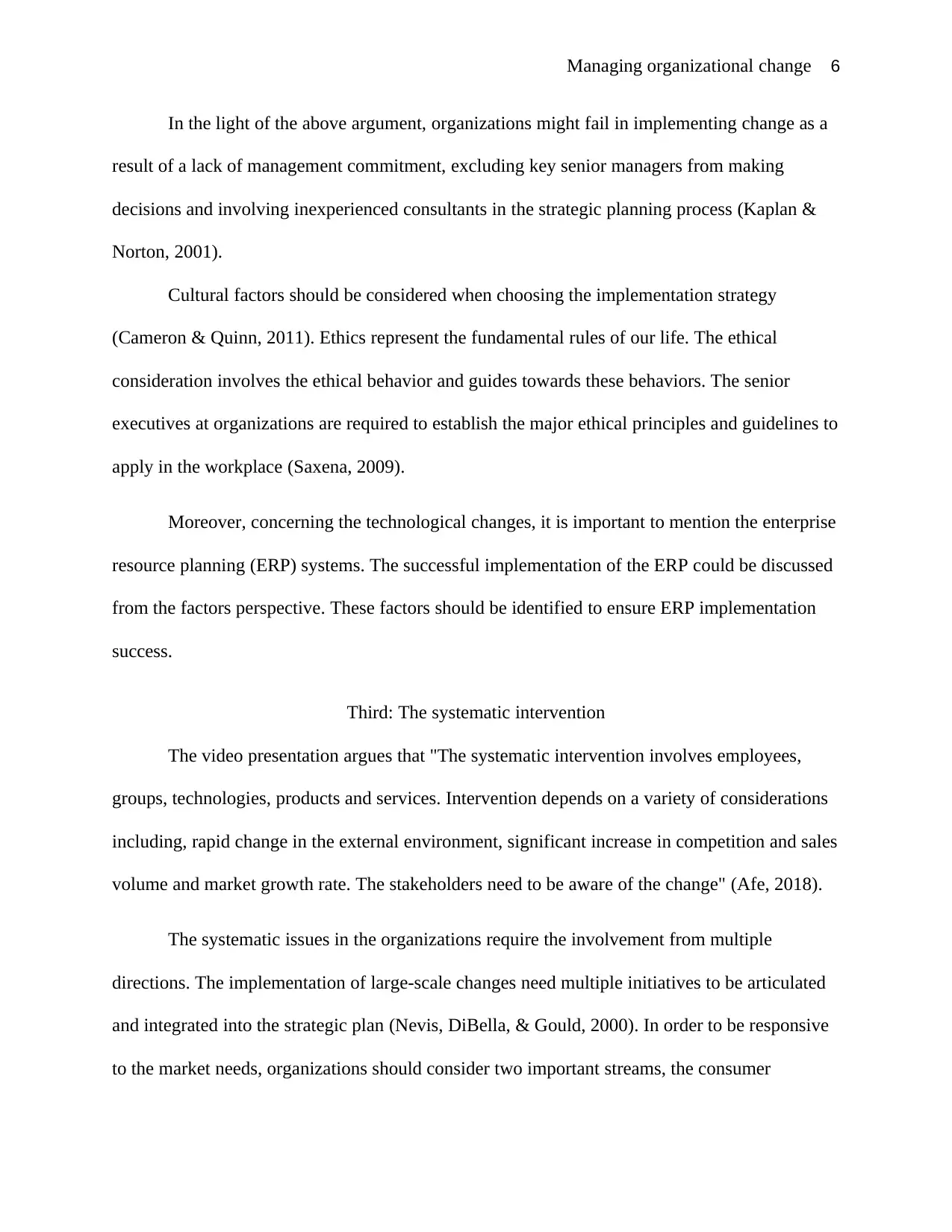
6Managing organizational change
In the light of the above argument, organizations might fail in implementing change as a
result of a lack of management commitment, excluding key senior managers from making
decisions and involving inexperienced consultants in the strategic planning process (Kaplan &
Norton, 2001).
Cultural factors should be considered when choosing the implementation strategy
(Cameron & Quinn, 2011). Ethics represent the fundamental rules of our life. The ethical
consideration involves the ethical behavior and guides towards these behaviors. The senior
executives at organizations are required to establish the major ethical principles and guidelines to
apply in the workplace (Saxena, 2009).
Moreover, concerning the technological changes, it is important to mention the enterprise
resource planning (ERP) systems. The successful implementation of the ERP could be discussed
from the factors perspective. These factors should be identified to ensure ERP implementation
success.
Third: The systematic intervention
The video presentation argues that "The systematic intervention involves employees,
groups, technologies, products and services. Intervention depends on a variety of considerations
including, rapid change in the external environment, significant increase in competition and sales
volume and market growth rate. The stakeholders need to be aware of the change" (Afe, 2018).
The systematic issues in the organizations require the involvement from multiple
directions. The implementation of large-scale changes need multiple initiatives to be articulated
and integrated into the strategic plan (Nevis, DiBella, & Gould, 2000). In order to be responsive
to the market needs, organizations should consider two important streams, the consumer
In the light of the above argument, organizations might fail in implementing change as a
result of a lack of management commitment, excluding key senior managers from making
decisions and involving inexperienced consultants in the strategic planning process (Kaplan &
Norton, 2001).
Cultural factors should be considered when choosing the implementation strategy
(Cameron & Quinn, 2011). Ethics represent the fundamental rules of our life. The ethical
consideration involves the ethical behavior and guides towards these behaviors. The senior
executives at organizations are required to establish the major ethical principles and guidelines to
apply in the workplace (Saxena, 2009).
Moreover, concerning the technological changes, it is important to mention the enterprise
resource planning (ERP) systems. The successful implementation of the ERP could be discussed
from the factors perspective. These factors should be identified to ensure ERP implementation
success.
Third: The systematic intervention
The video presentation argues that "The systematic intervention involves employees,
groups, technologies, products and services. Intervention depends on a variety of considerations
including, rapid change in the external environment, significant increase in competition and sales
volume and market growth rate. The stakeholders need to be aware of the change" (Afe, 2018).
The systematic issues in the organizations require the involvement from multiple
directions. The implementation of large-scale changes need multiple initiatives to be articulated
and integrated into the strategic plan (Nevis, DiBella, & Gould, 2000). In order to be responsive
to the market needs, organizations should consider two important streams, the consumer
⊘ This is a preview!⊘
Do you want full access?
Subscribe today to unlock all pages.

Trusted by 1+ million students worldwide
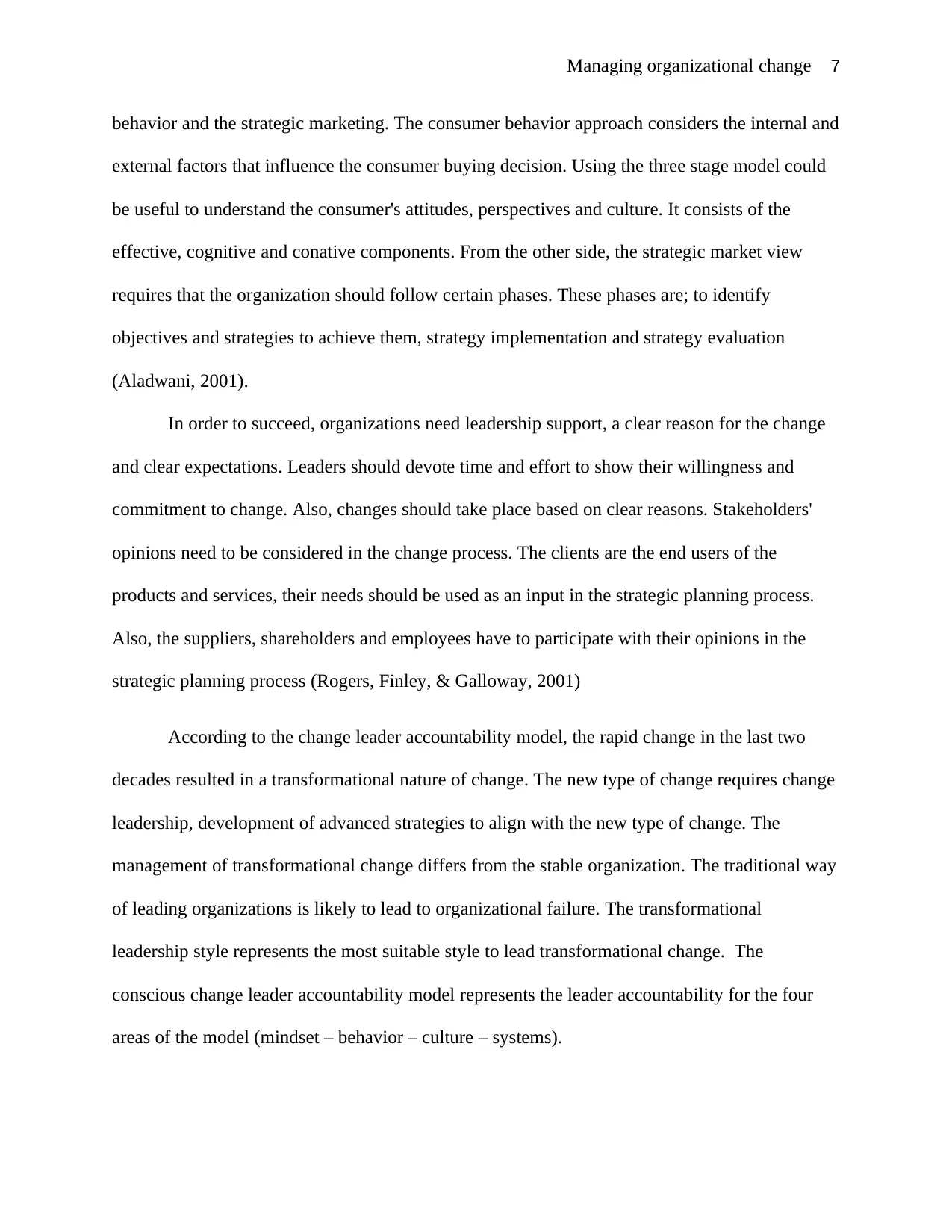
7Managing organizational change
behavior and the strategic marketing. The consumer behavior approach considers the internal and
external factors that influence the consumer buying decision. Using the three stage model could
be useful to understand the consumer's attitudes, perspectives and culture. It consists of the
effective, cognitive and conative components. From the other side, the strategic market view
requires that the organization should follow certain phases. These phases are; to identify
objectives and strategies to achieve them, strategy implementation and strategy evaluation
(Aladwani, 2001).
In order to succeed, organizations need leadership support, a clear reason for the change
and clear expectations. Leaders should devote time and effort to show their willingness and
commitment to change. Also, changes should take place based on clear reasons. Stakeholders'
opinions need to be considered in the change process. The clients are the end users of the
products and services, their needs should be used as an input in the strategic planning process.
Also, the suppliers, shareholders and employees have to participate with their opinions in the
strategic planning process (Rogers, Finley, & Galloway, 2001)
According to the change leader accountability model, the rapid change in the last two
decades resulted in a transformational nature of change. The new type of change requires change
leadership, development of advanced strategies to align with the new type of change. The
management of transformational change differs from the stable organization. The traditional way
of leading organizations is likely to lead to organizational failure. The transformational
leadership style represents the most suitable style to lead transformational change. The
conscious change leader accountability model represents the leader accountability for the four
areas of the model (mindset – behavior – culture – systems).
behavior and the strategic marketing. The consumer behavior approach considers the internal and
external factors that influence the consumer buying decision. Using the three stage model could
be useful to understand the consumer's attitudes, perspectives and culture. It consists of the
effective, cognitive and conative components. From the other side, the strategic market view
requires that the organization should follow certain phases. These phases are; to identify
objectives and strategies to achieve them, strategy implementation and strategy evaluation
(Aladwani, 2001).
In order to succeed, organizations need leadership support, a clear reason for the change
and clear expectations. Leaders should devote time and effort to show their willingness and
commitment to change. Also, changes should take place based on clear reasons. Stakeholders'
opinions need to be considered in the change process. The clients are the end users of the
products and services, their needs should be used as an input in the strategic planning process.
Also, the suppliers, shareholders and employees have to participate with their opinions in the
strategic planning process (Rogers, Finley, & Galloway, 2001)
According to the change leader accountability model, the rapid change in the last two
decades resulted in a transformational nature of change. The new type of change requires change
leadership, development of advanced strategies to align with the new type of change. The
management of transformational change differs from the stable organization. The traditional way
of leading organizations is likely to lead to organizational failure. The transformational
leadership style represents the most suitable style to lead transformational change. The
conscious change leader accountability model represents the leader accountability for the four
areas of the model (mindset – behavior – culture – systems).
Paraphrase This Document
Need a fresh take? Get an instant paraphrase of this document with our AI Paraphraser
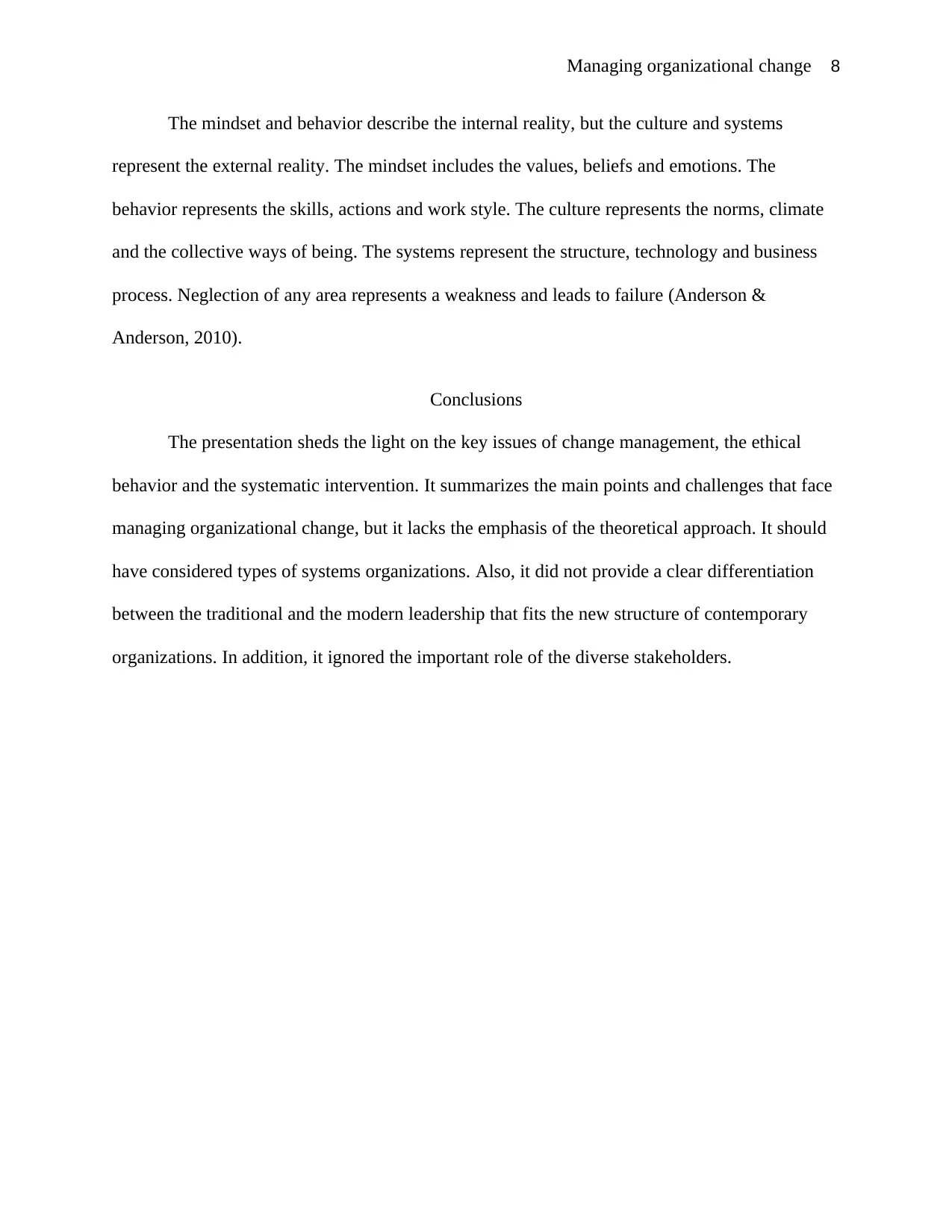
8Managing organizational change
The mindset and behavior describe the internal reality, but the culture and systems
represent the external reality. The mindset includes the values, beliefs and emotions. The
behavior represents the skills, actions and work style. The culture represents the norms, climate
and the collective ways of being. The systems represent the structure, technology and business
process. Neglection of any area represents a weakness and leads to failure (Anderson &
Anderson, 2010).
Conclusions
The presentation sheds the light on the key issues of change management, the ethical
behavior and the systematic intervention. It summarizes the main points and challenges that face
managing organizational change, but it lacks the emphasis of the theoretical approach. It should
have considered types of systems organizations. Also, it did not provide a clear differentiation
between the traditional and the modern leadership that fits the new structure of contemporary
organizations. In addition, it ignored the important role of the diverse stakeholders.
The mindset and behavior describe the internal reality, but the culture and systems
represent the external reality. The mindset includes the values, beliefs and emotions. The
behavior represents the skills, actions and work style. The culture represents the norms, climate
and the collective ways of being. The systems represent the structure, technology and business
process. Neglection of any area represents a weakness and leads to failure (Anderson &
Anderson, 2010).
Conclusions
The presentation sheds the light on the key issues of change management, the ethical
behavior and the systematic intervention. It summarizes the main points and challenges that face
managing organizational change, but it lacks the emphasis of the theoretical approach. It should
have considered types of systems organizations. Also, it did not provide a clear differentiation
between the traditional and the modern leadership that fits the new structure of contemporary
organizations. In addition, it ignored the important role of the diverse stakeholders.
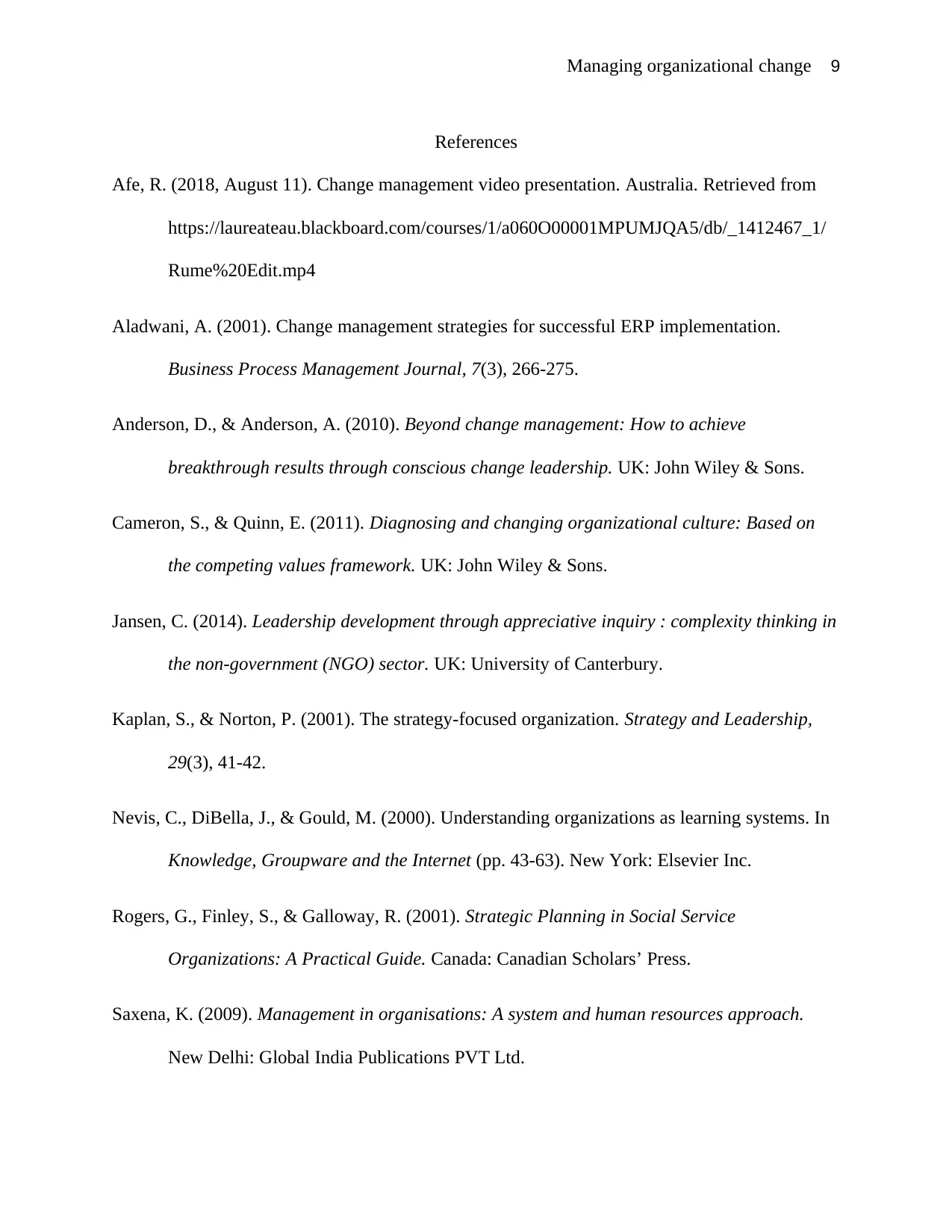
9Managing organizational change
References
Afe, R. (2018, August 11). Change management video presentation. Australia. Retrieved from
https://laureateau.blackboard.com/courses/1/a060O00001MPUMJQA5/db/_1412467_1/
Rume%20Edit.mp4
Aladwani, A. (2001). Change management strategies for successful ERP implementation.
Business Process Management Journal, 7(3), 266-275.
Anderson, D., & Anderson, A. (2010). Beyond change management: How to achieve
breakthrough results through conscious change leadership. UK: John Wiley & Sons.
Cameron, S., & Quinn, E. (2011). Diagnosing and changing organizational culture: Based on
the competing values framework. UK: John Wiley & Sons.
Jansen, C. (2014). Leadership development through appreciative inquiry : complexity thinking in
the non-government (NGO) sector. UK: University of Canterbury.
Kaplan, S., & Norton, P. (2001). The strategy-focused organization. Strategy and Leadership,
29(3), 41-42.
Nevis, C., DiBella, J., & Gould, M. (2000). Understanding organizations as learning systems. In
Knowledge, Groupware and the Internet (pp. 43-63). New York: Elsevier Inc.
Rogers, G., Finley, S., & Galloway, R. (2001). Strategic Planning in Social Service
Organizations: A Practical Guide. Canada: Canadian Scholars’ Press.
Saxena, K. (2009). Management in organisations: A system and human resources approach.
New Delhi: Global India Publications PVT Ltd.
References
Afe, R. (2018, August 11). Change management video presentation. Australia. Retrieved from
https://laureateau.blackboard.com/courses/1/a060O00001MPUMJQA5/db/_1412467_1/
Rume%20Edit.mp4
Aladwani, A. (2001). Change management strategies for successful ERP implementation.
Business Process Management Journal, 7(3), 266-275.
Anderson, D., & Anderson, A. (2010). Beyond change management: How to achieve
breakthrough results through conscious change leadership. UK: John Wiley & Sons.
Cameron, S., & Quinn, E. (2011). Diagnosing and changing organizational culture: Based on
the competing values framework. UK: John Wiley & Sons.
Jansen, C. (2014). Leadership development through appreciative inquiry : complexity thinking in
the non-government (NGO) sector. UK: University of Canterbury.
Kaplan, S., & Norton, P. (2001). The strategy-focused organization. Strategy and Leadership,
29(3), 41-42.
Nevis, C., DiBella, J., & Gould, M. (2000). Understanding organizations as learning systems. In
Knowledge, Groupware and the Internet (pp. 43-63). New York: Elsevier Inc.
Rogers, G., Finley, S., & Galloway, R. (2001). Strategic Planning in Social Service
Organizations: A Practical Guide. Canada: Canadian Scholars’ Press.
Saxena, K. (2009). Management in organisations: A system and human resources approach.
New Delhi: Global India Publications PVT Ltd.
⊘ This is a preview!⊘
Do you want full access?
Subscribe today to unlock all pages.

Trusted by 1+ million students worldwide
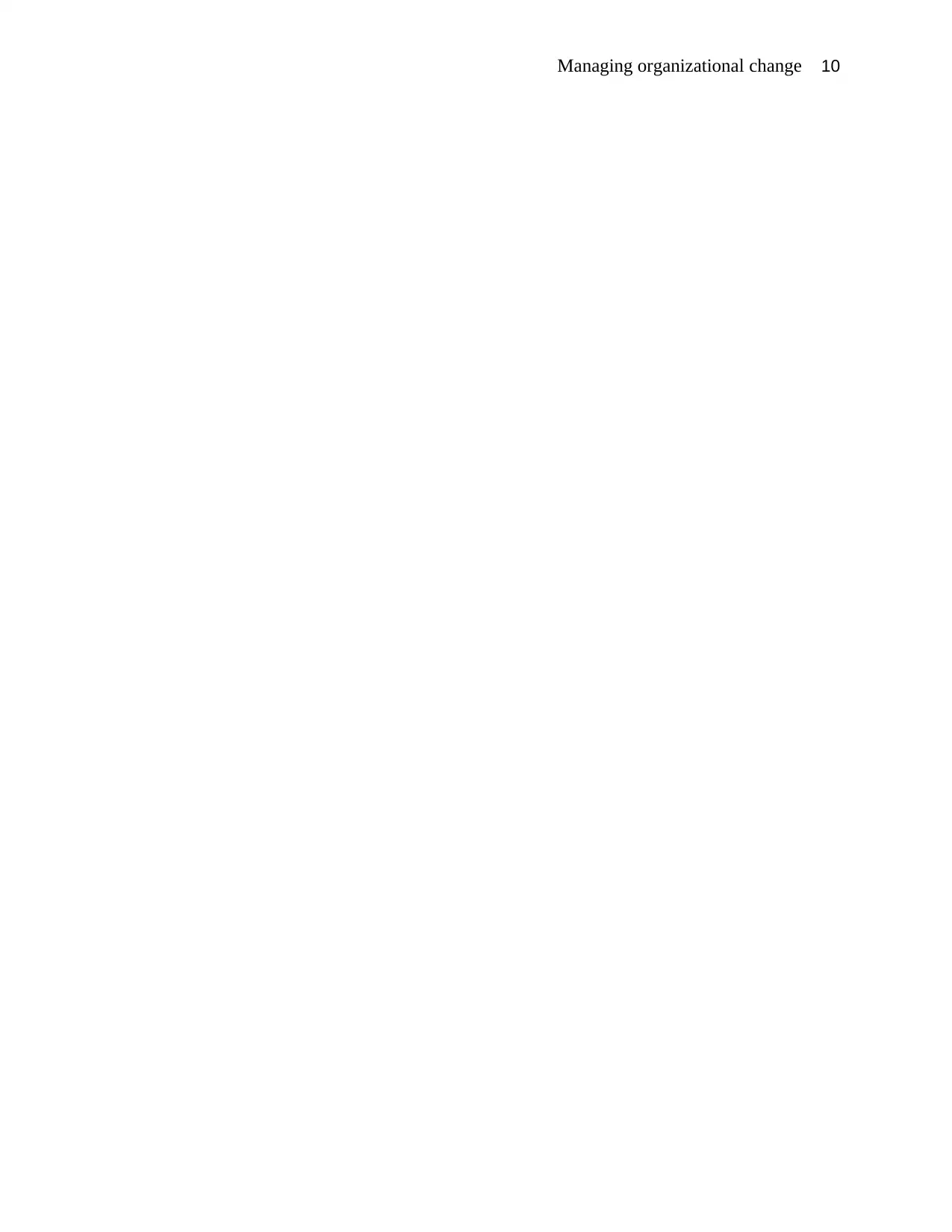
10Managing organizational change
1 out of 10
Related Documents
Your All-in-One AI-Powered Toolkit for Academic Success.
+13062052269
info@desklib.com
Available 24*7 on WhatsApp / Email
![[object Object]](/_next/static/media/star-bottom.7253800d.svg)
Unlock your academic potential
Copyright © 2020–2025 A2Z Services. All Rights Reserved. Developed and managed by ZUCOL.





